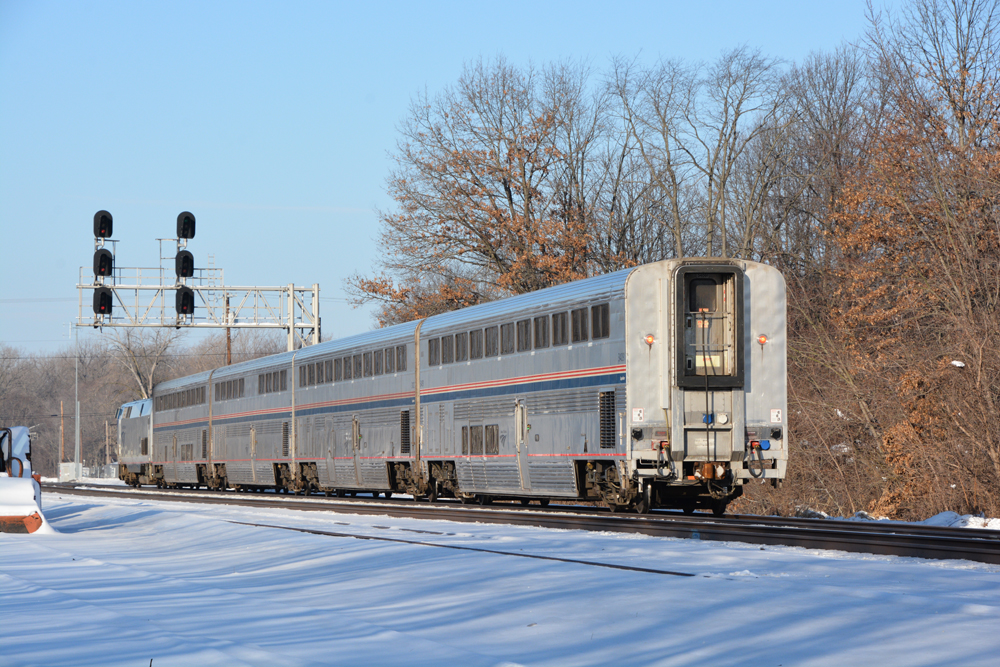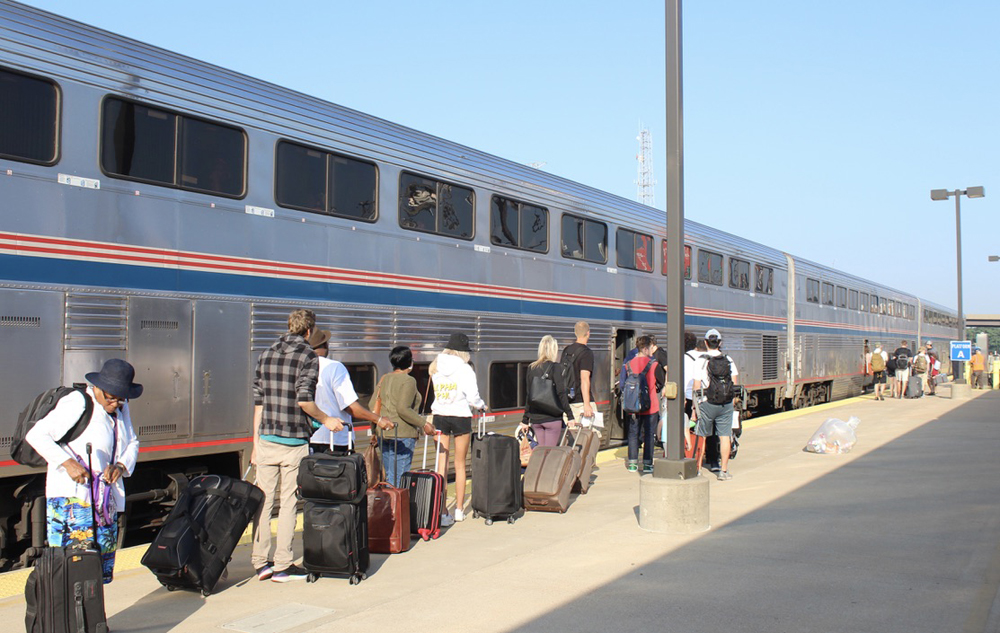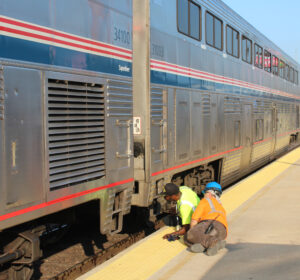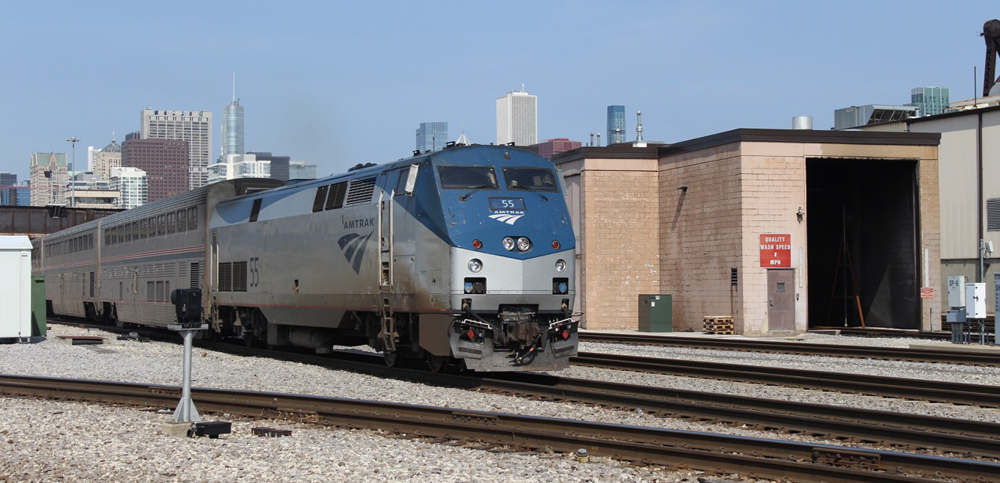
CHICAGO — Shared trainsets, running through between Washington D.C. and San Antonio, Texas, via Chicago, are part of the plan when the Texas Eagle and Capitol Limited resume daily operation on Monday, March 28. This will end a reduction to five-day-a-week departures that began in January.
The Eagle, between Chicago and San Antonio, and the Chicago-Washington Capitol will join the Seattle-Los Angeles Coast Starlight in returning to a daily schedule.
Amtrak announced earlier this month it was continuing five-day-a-week operation for six other trains, as well as the complete suspension of the New York-Miami Silver Meteor [see “Amtrak extends cuts to seven long-distance routes …,” Trains News Wire, March 3, 2022]. The reservation system at the Amtrak website currently shows daily service on those routes returning the week of May 23, although there is no guarantee that will happen.

Aiding the run-through plan, the Eagle and Capitol are similarly equipped Superliner trains. Currently, each has two coaches (a third coach is added in both directions to the Eagle between Chicago and St. Louis), one sleeping car, and one Cross Country Café, with a dining section for sleeping car passengers on one side and a snack bar on the other.
When daily operation begins, the inbound equipment from one train will become the other’s same-day outbound set. So Superliners arriving from San Antonio or Los Angeles (a coach and sleeping car connect with the triweekly Sunset Limited) will head east a few hours later to Washington, D.C. instead of being inspected, cleaned, and restocked in Chicago. Westbound, Capitol Limited cars arriving in the morning will continue to Texas and California. The two trains will retain their separate numbers, and passengers passing through Chicago won’t be allowed to stay onboard.
The move reduces the number of equipment sets the trains need for daily operation from seven (four for the Eagle and three for the Capitol) to six by effectively moving the Eagle’s eastern overnight servicing layover from Chicago to Washington, D.C. There, the Capitol Limited’s arrival and departure times allow 24 hours for servicing before the trainset heads west again. Thus, the Superliners will forego pit inspections of their running gear for 3,500 to nearly 4,200 miles, depending on whether cars turn at San Antonio or Los Angeles.
Operating challenges
Amtrak implies that efficiency derived from creating this run-through makes possible the return of daily operation for both trains. But the change introduces operating challenges and potential service-degradation issues for passengers.
These include:

— A 2-hour St. Louis layover. The federally required 1,500-mile inspection of the trains equipment moves from Chicago to St. Louis. To allow sufficient time for this, a lengthy layover has been created there. With the Eagle’s St. Louis-San Antonio timings unchanged in both directions, and because the train no longer has a Sightseer Lounge car, this means through passengers must either leave the train or are confined to their seat or sleeping accommodation for 2 hours, 10 minutes westbound and just under two hours coming east. Today, a half-hour dwell time allows the Chicago-St. Louis cut-off coach to be switched. Similar mid-route inspections on Chicago-West Coast trains range from 20 to no more than 40 minutes.
— Capitol Limited timekeeping. While the train from Washington, D.C. is scheduled into Chicago at 8:45 a.m., Norfolk Southern freight congestion in Indiana often pushes it back much later. In the week ending March 24, Chicago arrivals ranged from 10:21 a.m. to 10:43 a.m. The Eagle’s new departure time is 11:55 a.m., but since March 1, the Capitol arrived after noon three times, including at 1:30 p.m. on March 7. Presumably, up to 10 minutes will also be added to facilitate a back-up move into the Union Station that will allow locomotives or defective cars to be replaced, if needed, and the St. Louis coach to be added or dropped.
— Spotty servicing. There won’t be enough time to move the train to the Chicago maintenance facility, which in any case has been plagued by late departures for reasons that Amtrak has repeatedly declined to specify. “No-service” departure days on the five per-week schedule eliminate two long-distance train starts every day, and this change takes out up to two more.

Cleaning of run-through trains in the station has been attempted twice before when Amtrak briefly operated a combined Capitol Limited-Southwest Chief (through ticketing was offered), and later when the Eagle’s equipment was paired with the City of New Orleans. Coach cleaners routinely give corridor trains a once-over in stations, but it remains to be seen whether mechanical issues that may develop over days of continuous travel can be satisfactorily rectified in the limited time and resources available.
Of course, there are no plans to move trains through the Chicago car washer, though Amtrak has only offered excuses as to why this is rarely done today anywhere on the system even when equipment spends the night.
Connections increase
On the plus side, any resumption of daily service will have a positive impact on the company’s revenue and ridership through enhanced connection options. Currently, anyone wishing to travel from, say, Little Rock Ark., to Pittsburgh on these two trains can only depart Saturday through Tuesday. If the destination is Syracuse, N. Y., via a five-day-per-week connection in Chicago with the Lake Shore Limited, departure day options will expand from Friday through Sunday to Wednesday through Sunday.
At least it’s a start.














I took my grandkids on a long awaited trip to Chicago last June via the Heartland Flyer/Texas Eagle (after full menus had been restored on many LD trains)…not the Eagle…microwave etc with hot dogs being the only item kids would eat…but the worst was the sleeper being right behind the engine in both directions…needless to say grandpa didn’t get a lot of sleep…a REALLY loud horn!! The crew said the positioning was always that way due to the switching in San Antonio..My complaint to Amtrak got me a $200 voucher!! (by the way…why is Amtrak still passing up millions in additional revenue due to greatly reduced private car use every year by still not allowing platform/dutch door viewing on private cars????)
Amtrak is a great case study in the reasons why the government should not run any type of business. Long-distance passenger rail doesn’t exist in the private sector for a very good reason.
I love passenger trains but riding Amtrak seems more like punishment than a relaxing ride. Dirty windows , no real diner or decent lounge, sleepers that are way overpriced for a rattle filled ride, not to mention masks.
Funny, I never had a bad trip when the railroads were running their own trains even up to May 1st ,71.
Ever since Amtrak discontinued the Broadway Ltd.route from New York to Chicago I usually used the Capitol Ltd. from Washington D.C. to Chicago. I have in the past ridden both regional and long distance trains for both business and pleasure. However even though I am now retired I haven’t ridden any long distance train. As many others commented the on board service has gone down and I believe they should allow coach passengers to use the dinning car. One example where this would affect me is when I traveled to Minneapolis from Philadelphia. I usually used a sleeper from Washington to Chicago but since it was a daytime run from Chicago to Minneapolis I always road in coach. This train runs during the usual dinner time and I always ate dinner in the dinning car. With the new Amtrak policy I have not ridden the train there. I also feel if there is no dinning car for coach passengers there should at least be a full service lounge car with an expanded food variety available. Not to mention one of the major difference in transportation choices was the availability to socialize with other passengers in the lounge car. With the Capitol Ltd. And the Texas Eagle not providing this service, it is just one more reason not to ride the train.
We’re seeing the beginning of the end for Gardner’s sorry company.
I am now retired and finally have time to ride Amtrak again purely for enjoyment. However, after seven years, I have yet to take a trip. Too many horror stories. I was encouraged lately with Congress appropriating significant funding. But after reading the above I am pessimistic Amtrak will ever improve.
We have a pro-Amtrak president and a pro-Amtrak USDOT Secretary —- and all that cash being thrown at it. Never has Amtrak been such a squalid mess.
For 50+ years I have ridden Amtrak and mostly enjoyed the trips (Amtrak was 2 weeks old the date of my first trip) and through all the changes have really tried to give them the benefit of the doubt, but of late it simply gets worse and worse. The worst part now is that I doubt it will change.
Watched a car knocker change a superliner trucks shock snubber at Albuquerque while the express during the inspection there. This was a routine stop that allowed passengers to shop the native shops. Didn’t exceed the scheduled time and fortunately, nice sunshine. No cover or shelter. St. Louis has worse weather.
It would be useful to know in brief what is required in a 1,500-mile inspection. The STL Union Station platforms are not sheltered – no overhead protection like the platforms at Washington, Chicago, or New Orleans. I don’t doubt the professionalism of the mechanical forces, but doing a thorough inspection of cars in STL during inclement weather can be a challenge.
God bless Graham Claytor. The golden age of Amtrak. Still remember the duplex diner on 97/98 serving food cafeteria style, but with a server taking the trays to your table and bringing beverages. And the food was GOOD and plentiful.
At first I thought this might be a rare case of Amtrak actually using equipment more efficiently, but then I when I saw the deferred maintenance issues, and strong possibilities of late arrivals in Chicago, I decided this won’t work. The downsides will more than offset the benefits, especially after three months. Did anyone at Amtrak dig into the files to find out why the previous experiments to avoid cleaning and servicing coaches in Chicago did not work? Oh, the only people, who would know, are either retired, or deceased. Give management a B+ for thinking outside the box, but a D the results. TBD.
If pax are allowed out of the St Louis platform area, they could walk to Union Station, where they can get something other than Amtrak cafe food.
to me ,it points to a problem with the Chicago servicing facility , and it wouldn’t be the first time.
They will change this within 3 months. There’s only so much you can do wandering around the platform at St. Louis.
To be fair (as a defender of airlines), an airline adding a stop compared to a nonstop could take somewhere around two hours – the approach and landing, taxiing to the gate, time at gate, then getting airborne and on route again. That adds a significant amount of time. Time that through passengers are confined to their not terribly comfortable seats with nothing to do.
The point is, trains already take too much time, already go too slow and already are too inconvenient. Let’s not add to that.
This will soon be a disaster in the making. Amtrak continues to cover managements butt for poor planning and mistakes. Amtrak making noise about expanding service and can’t provide it now. Congress even took out the demand for making money and instead to focus on service. But service continues to be overpriced and deteriorate. How well will this equipment be serviced in Chicago. If 29 comes in late, and it often does, how much pressure will be placed on everyone to get the train out on time no matter what? Don’t want those numbers to look bad for management.
The above says it all. What a jackass move.
As an old man who remembers the heyday of passenger trains in the early ’50s, all I can say is this is a Sad Way To Run a “railroad”. I hope that this is temporary until staffing increases, new equipment is purchased and intelligent management (oxymoron?) arrives to improve things.
“Intelligent management” seems to be an oxymoron in the transportation business, railroads and airlines.
They seem to draw less than top-flight management.
Why not the lounge car,
Why not a full dining car service. The Texas Eagle is a America train
Not some from Europe, or China.
America love our trains the long distance passengers services most of all. They must have personal that don’t know how to run passengers services.
Please call your Congress and Senators, we want more routes added
Certainly should have lounge and dinning car, and available to coach passengers. New routes take time to start up. I’m not as skeptical as some people here, though I hope I am not wrong.
No America doesn’t love trains.. Hence Amtrak’s <1% ridership…..
There is some truth to that, but there would be more ridership if the trains actually met the needs of people, in time of arrival and departure, and more than one train a day.
That’s why there’s a lot more ridership on the NE corridor.
Long distance passenger trains in the U.S. are an anachronism. They serve no useful purpose and are only around because some politicians wield them for political power/votes. Passenger rail in Europe is viable for all the obvious reasons, none of which is “because people just like riding trains.”
I rode the Eagle between San Antonio and Dallas four times in 2021. The equipment was as clean, at least on the interior, as I have ever seen it. And I have been riding the Eagle or its predecessor since 1980.
I usually travel in an economy room. But as often as not I grab a sandwich or pizza and a beverage in the lounge car. The food is as good if not better than the food in the dining car. I have not encountered many coach passengers that take the train so they can eat in the dining car.
Not only should the train’s exterior be washed, but will the bathrooms be cleaned and carpets vacuumed ? Will spare cars be available at St.Louis to swap out for cars that develop defects e route.
It would make more sense to me to keep the WB Eagle’s normal departure time at Chicago, and then the extended servicing at St. Louis would allow a more reasonable arrival time in Little Rock than 3:15 AM. There’s all kinds of extra time already built in to the schedule for Marshall, TX, and Ft. Worth as well as San Antón.
In this chapter of Amtrak’s How to Destroy the National Network – Dirty Trains. They seem to be using the same playbook the RR’s did to drive away customers. The next chapter as alluded to in the story will be lack of serviceable equipment. Why then are they purchasing new LD motive power when they will not have operable cars for them to operate? To deceive Congress with the illusion they are fulfilling the LD investment directives while most likely siphoning that money into that last place nag the NEC.
Still no connection Florida to/from west. Appalling!!!!!!!!!!!!!!!!!!!!!!!!!!!!!1
Both the equipment shortfall and the excuses (and still no dining facility for coach passengers) are appalling.
It’s appalling that some people continue to label Amtrak as railroad. Amtrak isnt a railroad, it’s a joke,
While Amtrak Joe is in Poland this week he might ask how it is that the railroads of Germany, Ukraine, Slovakia, Poland, Czechia, etc. moved those millions of refugees. Amtrak or VIA Rail couldn’t do that.